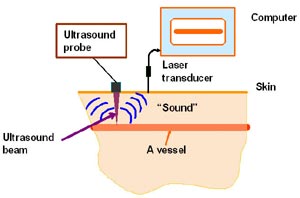A New Way To See Vessels in the Human Body

Vessels are important parts of our body. Their function is critical to our well-being. For years, doctors have tried various tools to take pictures of arteries that would help them in diagnosing or preventing diseases. This has not been an easy task, however, and sometimes they have to use imaging methods that may have some harmful side effects. It has always been a challenge to take clear pictures of vessel without the negative side effects. Here, we suggest a new way that may help us to achieve this goal.
Vessels in our body are narrow tubes, with many branches along the way. Each segment may be thought of as a string, much like a piano string, extending from one point to another. Hammering on a piano string helps a tuner to “visualize” the string and find out if the string is in a good condition or not. We use the same concept, but with more sophistication, in our new imaging method. In our method, we tap a vessel to make it vibrate at its natural tone, and we record the sound produce by the “singing” vessel. As we move the tapping point across the area around the vessel, we record the sound and map point-by-point to make an image. The sound would be strong only if we are tapping on the vessel. The result is a “picture” of the vessel. This picture actually shows the vibration or sound of the vessel, so we may call it a “sound” image. If there is a change in vessel properties, for example due to a disease, the change will effect the natural tone of the vessel and therefore would be visible in this “sound” image.
In practice, the tapping is done with a specially designed ultrasound probe and the sound is recorded by a sensitive laser system that detects vessel vibrations from outside. This way we do not need to have direct access to the vessel. The method is considered safe because we do not use harmful radiations. Our initial experiments on objects resembling human vessels have shown promising results.
Media Contact
More Information:
http://www.acoustics.org/press/145th/Zhang.htmAll latest news from the category: Health and Medicine
This subject area encompasses research and studies in the field of human medicine.
Among the wide-ranging list of topics covered here are anesthesiology, anatomy, surgery, human genetics, hygiene and environmental medicine, internal medicine, neurology, pharmacology, physiology, urology and dental medicine.
Newest articles

Sea slugs inspire highly stretchable biomedical sensor
USC Viterbi School of Engineering researcher Hangbo Zhao presents findings on highly stretchable and customizable microneedles for application in fields including neuroscience, tissue engineering, and wearable bioelectronics. The revolution in…

Twisting and binding matter waves with photons in a cavity
Precisely measuring the energy states of individual atoms has been a historical challenge for physicists due to atomic recoil. When an atom interacts with a photon, the atom “recoils” in…

Nanotubes, nanoparticles, and antibodies detect tiny amounts of fentanyl
New sensor is six orders of magnitude more sensitive than the next best thing. A research team at Pitt led by Alexander Star, a chemistry professor in the Kenneth P. Dietrich…





















